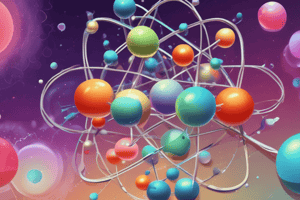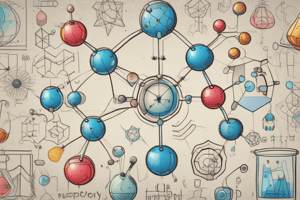Podcast
Questions and Answers
What was the main conclusion of Rutherford's gold foil experiment?
What was the main conclusion of Rutherford's gold foil experiment?
- The nucleus contains both protons and neutrons.
- Atoms are mostly empty space with a small, dense, positively charged nucleus. (correct)
- Atoms are solid spheres with electrons embedded throughout.
- Electrons orbit the nucleus in specific energy levels.
Which of the following was NOT directly observed by Rutherford in his gold foil experiment?
Which of the following was NOT directly observed by Rutherford in his gold foil experiment?
- Alpha particles were repelled and deflected backwards.
- The nucleus contains neutrons. (correct)
- Alpha particles were deflected at various angles.
- Some alpha particles passed straight through the gold foil.
What evidence led Chadwick to conclude that the nucleus contains neutrons?
What evidence led Chadwick to conclude that the nucleus contains neutrons?
- The observation that electrons orbit the nucleus in specific energy levels.
- The observation that the masses of nuclei were not the same as the sum of the masses of protons. (correct)
- The observation that alpha particles were deflected at various angles.
- The observation that atoms emit certain colors of light.
What occurs when an electron jumps from a higher energy level to a lower energy level?
What occurs when an electron jumps from a higher energy level to a lower energy level?
What is the outermost energy level of an atom called?
What is the outermost energy level of an atom called?
What is the primary function of Bohr-Rutherford diagrams?
What is the primary function of Bohr-Rutherford diagrams?
Which of the following statements is TRUE about Bohr's model of the atom?
Which of the following statements is TRUE about Bohr's model of the atom?
Which scientist's work led to the understanding that electrons exist in specific energy levels?
Which scientist's work led to the understanding that electrons exist in specific energy levels?
What determines the identity of an element?
What determines the identity of an element?
Which of the following is NOT a nuclear particle?
Which of the following is NOT a nuclear particle?
What is the neutron number (N) of an atom with an atomic number (Z) of 8 and mass number (A) of 16?
What is the neutron number (N) of an atom with an atomic number (Z) of 8 and mass number (A) of 16?
Which isotope of carbon is the standard used for comparing atomic masses?
Which isotope of carbon is the standard used for comparing atomic masses?
What is the function of a mass spectrometer?
What is the function of a mass spectrometer?
Which type of radiation is most likely to penetrate deep into body tissue?
Which type of radiation is most likely to penetrate deep into body tissue?
What element is the radioactive noble gas that can accumulate in homes and contribute to lung cancer risk?
What element is the radioactive noble gas that can accumulate in homes and contribute to lung cancer risk?
Whose law of triads organized elements into groups of three with similar properties?
Whose law of triads organized elements into groups of three with similar properties?
Which of these is NOT a common characteristic of radioactive isotopes?
Which of these is NOT a common characteristic of radioactive isotopes?
What is the difference between alpha radiation and beta radiation?
What is the difference between alpha radiation and beta radiation?
Which of these options is NOT a reason why periodic trends occur?
Which of these options is NOT a reason why periodic trends occur?
Which of the following best describes the effect of shielding on the effective nuclear charge?
Which of the following best describes the effect of shielding on the effective nuclear charge?
What is the relationship between the number of protons in an atom and the nuclear charge?
What is the relationship between the number of protons in an atom and the nuclear charge?
Which of the following statements is true for elements in the same period?
Which of the following statements is true for elements in the same period?
Why are Li, Na, and K in the same group on the periodic table?
Why are Li, Na, and K in the same group on the periodic table?
What is the relationship between the position of an element on the periodic table and its electron configuration?
What is the relationship between the position of an element on the periodic table and its electron configuration?
Which of these is NOT a factor that influences the effective nuclear charge experienced by an electron in an atom?
Which of these is NOT a factor that influences the effective nuclear charge experienced by an electron in an atom?
Which of the following is TRUE about trends in the periodic table?
Which of the following is TRUE about trends in the periodic table?
What does Schrodinger's Quantum Mechanical Model not have regarding electrons?
What does Schrodinger's Quantum Mechanical Model not have regarding electrons?
What is the maximum number of valence electrons that hydrogen and helium can have to achieve a stable octet?
What is the maximum number of valence electrons that hydrogen and helium can have to achieve a stable octet?
What type of ion is formed when an atom loses one or more electrons?
What type of ion is formed when an atom loses one or more electrons?
Which group of elements generally has a stable arrangement of 8 valence electrons?
Which group of elements generally has a stable arrangement of 8 valence electrons?
Which of the following represents a nonmetal ion that typically gains electrons?
Which of the following represents a nonmetal ion that typically gains electrons?
How can an atom achieve a stable electron arrangement according to the octet rule?
How can an atom achieve a stable electron arrangement according to the octet rule?
What is the predicted behavior of metals with respect to their valence electrons?
What is the predicted behavior of metals with respect to their valence electrons?
In a Bohr-Rutherford diagram, how should an ion be represented?
In a Bohr-Rutherford diagram, how should an ion be represented?
What does the Cl– ion represent?
What does the Cl– ion represent?
What is the valence of an atom?
What is the valence of an atom?
Which statement is true about multivalent elements?
Which statement is true about multivalent elements?
How are isotopes of an element distinguished?
How are isotopes of an element distinguished?
What characterizes a polyatomic ion?
What characterizes a polyatomic ion?
What role do protons play in an atom?
What role do protons play in an atom?
Electrons primarily determine which aspect of an atom?
Electrons primarily determine which aspect of an atom?
What is the significance of neutrons in isotopes?
What is the significance of neutrons in isotopes?
Which of the following statements regarding the atomic radius of elements is TRUE?
Which of the following statements regarding the atomic radius of elements is TRUE?
Which of the following statements best describes the trend in ionization energy (IE) across a period?
Which of the following statements best describes the trend in ionization energy (IE) across a period?
Which of the following correctly describes the relationship between electron affinity and atomic radius?
Which of the following correctly describes the relationship between electron affinity and atomic radius?
Why is the ionic radius of a cation smaller than that of its parent atom?
Why is the ionic radius of a cation smaller than that of its parent atom?
Which of the following statements correctly describes the relationship between electronegativity and atomic radius?
Which of the following statements correctly describes the relationship between electronegativity and atomic radius?
Which of the following elements would have the highest ionization energy?
Which of the following elements would have the highest ionization energy?
Which of the following statements about electron affinity is FALSE?
Which of the following statements about electron affinity is FALSE?
Which of the following statements correctly describes the relationship between electron affinity and ionization energy?
Which of the following statements correctly describes the relationship between electron affinity and ionization energy?
Which of the following elements has the highest electronegativity?
Which of the following elements has the highest electronegativity?
A neutral atom gains an electron. What type of ion is formed?
A neutral atom gains an electron. What type of ion is formed?
Which of the following statements regarding ionization energy is FALSE?
Which of the following statements regarding ionization energy is FALSE?
What is the main reason for the trend in electronegativity across a period?
What is the main reason for the trend in electronegativity across a period?
Which of the following elements would form the most stable anion?
Which of the following elements would form the most stable anion?
Which of the following ions has the smallest ionic radius?
Which of the following ions has the smallest ionic radius?
Which of the following statements about the trends in ionization energy and electronegativity are TRUE?
Which of the following statements about the trends in ionization energy and electronegativity are TRUE?
Flashcards
Rutherford's Gold Foil Experiment
Rutherford's Gold Foil Experiment
An experiment where positively charged alpha particles were fired at a thin sheet of gold foil to determine the structure of an atom.
Rutherford's Nuclear Model
Rutherford's Nuclear Model
Atoms are mostly empty space with a dense, positively charged nucleus at the center and negatively charged electrons orbiting at a distance.
Nucleus
Nucleus
The small, positively charged core of an atom, containing protons and neutrons.
Neutron
Neutron
Signup and view all the flashcards
Bohr's Atomic Model
Bohr's Atomic Model
Signup and view all the flashcards
Energy Level
Energy Level
Signup and view all the flashcards
Valence Shell
Valence Shell
Signup and view all the flashcards
Valence Electron
Valence Electron
Signup and view all the flashcards
Schrödinger's Quantum Mechanical Model
Schrödinger's Quantum Mechanical Model
Signup and view all the flashcards
Stable Octet
Stable Octet
Signup and view all the flashcards
Octet Rule
Octet Rule
Signup and view all the flashcards
Ion
Ion
Signup and view all the flashcards
Cation
Cation
Signup and view all the flashcards
Anion
Anion
Signup and view all the flashcards
Emission Spectrum
Emission Spectrum
Signup and view all the flashcards
Spectral Lines
Spectral Lines
Signup and view all the flashcards
What is an anion?
What is an anion?
Signup and view all the flashcards
What is valence?
What is valence?
Signup and view all the flashcards
What is a multivalent atom?
What is a multivalent atom?
Signup and view all the flashcards
What is a polyatomic ion?
What is a polyatomic ion?
Signup and view all the flashcards
What is an isotope?
What is an isotope?
Signup and view all the flashcards
What is the nucleus?
What is the nucleus?
Signup and view all the flashcards
What are protons?
What are protons?
Signup and view all the flashcards
What are electrons?
What are electrons?
Signup and view all the flashcards
Atomic Number (Z)
Atomic Number (Z)
Signup and view all the flashcards
Atomic Mass (A)
Atomic Mass (A)
Signup and view all the flashcards
Period
Period
Signup and view all the flashcards
Group/Family
Group/Family
Signup and view all the flashcards
Effective Nuclear Charge (ENC)
Effective Nuclear Charge (ENC)
Signup and view all the flashcards
Electron-Electron Repulsion
Electron-Electron Repulsion
Signup and view all the flashcards
Mass Number (A)
Mass Number (A)
Signup and view all the flashcards
Neutron Number (N)
Neutron Number (N)
Signup and view all the flashcards
Relative/Average Atomic Mass
Relative/Average Atomic Mass
Signup and view all the flashcards
Atomic Mass Unit (u)
Atomic Mass Unit (u)
Signup and view all the flashcards
Isotopic Abundance
Isotopic Abundance
Signup and view all the flashcards
Mass Spectrometer
Mass Spectrometer
Signup and view all the flashcards
Radioisotope
Radioisotope
Signup and view all the flashcards
Nuclear Radiation
Nuclear Radiation
Signup and view all the flashcards
Atomic Radius
Atomic Radius
Signup and view all the flashcards
Ionization Energy (IE)
Ionization Energy (IE)
Signup and view all the flashcards
Electron Affinity
Electron Affinity
Signup and view all the flashcards
Electronegativity
Electronegativity
Signup and view all the flashcards
Ionic Radius
Ionic Radius
Signup and view all the flashcards
Atomic Radius Trend: Down a Group
Atomic Radius Trend: Down a Group
Signup and view all the flashcards
Atomic Radius Trend: Across a Period
Atomic Radius Trend: Across a Period
Signup and view all the flashcards
Ionization Energy Trend: Across a Period
Ionization Energy Trend: Across a Period
Signup and view all the flashcards
Ionization Energy Trend: Down a Group
Ionization Energy Trend: Down a Group
Signup and view all the flashcards
Electron Affinity Trend: Across a Period
Electron Affinity Trend: Across a Period
Signup and view all the flashcards
Electron Affinity Trend: Down a Group
Electron Affinity Trend: Down a Group
Signup and view all the flashcards
Electronegativity Trend: Across a Period
Electronegativity Trend: Across a Period
Signup and view all the flashcards
Electronegativity Trend: Down a Group
Electronegativity Trend: Down a Group
Signup and view all the flashcards
Study Notes
Unit 1.2: Elements and Atoms
- Element: A substance that cannot be broken down into simpler substances through a chemical reaction. All matter is composed of elements.
- Atom: The smallest possible unit of an element. Greek for "not able to be cut."
Democritus and Aristotle
- Democritus: Proposed the concept of "atomos" (uncuttable) atoms, different sizes, constant motion, and separated by empty space.
- Aristotle: Proposed the "Four Element Model" (fire, air, earth, water), an idea that lasted for 2,000 years.
Alchemists
- 1st - 17th Century: Explored matter intensely. Searched for the "elixir of life," philosopher's stone (to transform metals into gold). Developed lab glassware and chemical handling procedures. Discovered various elements (arsenic, antimony, bismuth, phosphorus).
Dalton's Billiard Ball Model (1808)
- Experiment: Broke down water using electricity.
- Observations: Hydrogen and oxygen gas were produced, with different properties from water.
- Conclusion: Water is a compound. Matter is made of tiny, indivisible particles (atoms).
- Atoms of the same element are identical in mass and size.
- Atoms of different elements have different masses and sizes.
- Compounds are formed when atoms of different elements combine in definite proportions.
- Atoms cannot be created, destroyed, or divided in chemical reactions.
Thomson's Plum Pudding Model (1904)
- Experiment: Cathode Ray Tube experiment.
- Observations: A ray was produced starting from the negative electrode (cathode). The ray was repelled by a negatively charged pole.
- Conclusion:
- Atoms contain negatively charged particles (electrons).
- Electrons are small and have negative charges.
- Atoms are spheres of positive charge with negatively charged electrons embedded within.
Rutherford's Nuclear Model (1911)
- Experiment: Alpha particles were fired at a thin gold foil.
- Observations: Most particles passed straight through, but some were deflected at large angles, some bounced back.
- Conclusion:
- Atoms are mostly empty space.
- Atoms contain a small, dense, positively charged nucleus.
- Electrons orbit the nucleus at a distance.
Chadwick's Discovery (1932)
- Experiment: Worked with Rutherford.
- Observations: Observed differences in the mass of atomic nuclei.
- Conclusion: Nuclei contain neutral particles called neutrons, along with positively charged protons.
Bohr's Planetary Model (1913)
- Experiment: Applied electricity and thermal energy to hydrogen gas. Observed light through a prism.
- Observations: Hydrogen atoms emitted light only at specific colors.
- Conclusion: Electrons orbit the nucleus in specific energy levels. Each energy level can hold a certain number of electrons. Jumping from one level to another releases light.
Bohr-Rutherford Diagrams
- Diagrams that show the number of subatomic particles (protons, neutrons, electrons) and their arrangement in atoms.
Schrodinger's Quantum Mechanical Model (1926)
- Does not have well-defined orbits for electrons.
- Describes electron position as a "cloud of probability."
Stable Octet
- Electron arrangement where the valence shell is full with 8 valence electrons (2 for hydrogen and helium). This is true for the first 18 elements.
Ion
- A charged atom formed when an atom gains or loses electrons.
- Cations: Positively charged ions (metals).
- Anions: Negatively charged ions (nonmetals).
Polyatomic Ions
- Ions composed of more than one atom.
Subatomic Particles
- Protons: Positively charged particles in the nucleus.
- Neutrons: Neutral particles in the nucleus.
- Electrons: Negatively charged particles orbiting the nucleus.
Isotopes
- Atoms of the same element with different numbers of neutrons. They exhibit similar chemical properties, differing in some physical properties.
Standard Atomic Notation
- A method to represent isotopes with atomic number and mass number.
Relative/Average Atomic Mass
- The weighted average mass of all naturally occurring isotopes of an element.
Atomic Mass Unit
- A unit of mass equal to 1/12 the mass of a carbon-12 atom.
Mass Spectrometer
- An instrument that measures isotopic abundances.
Radioisotopes
- Isotopes with unstable nuclei; they emit radiation to achieve a more stable state. This may have medical, energetic, or other applications.
Radiation Protection
- Methods to protect against harmful effects of radiation.
Periodic Table
- Organizes elements by increasing atomic number, with elements exhibiting similar properties in columns (groups).
Periodic Law
- Physical properties repeat regularly as elements are arranged by increasing atomic number.
Periodic Trends
- Patterns observed in properties of elements as you move across or down the periodic table (e.g., atomic radius, ionization energy, electronegativity).
Effective Nuclear Charge
- The net positive charge experienced by an outer electron in an atom, which includes the attraction of positively charged protons and reduced attraction due to shielding by inner electrons.
Electron Affinity
- The energy change that occurs when a neutral atom gains an electron.
Electronegativity
- The relative ability of an atom to attract shared electrons in a covalent bond.
Studying That Suits You
Use AI to generate personalized quizzes and flashcards to suit your learning preferences.
Related Documents
Description
Explore the fundamental concepts of elements and atoms in this quiz. Delve into the historical perspectives of Democritus and Aristotle, and discover the contributions of early alchemists and Dalton's experiments. Test your knowledge on the building blocks of matter!




